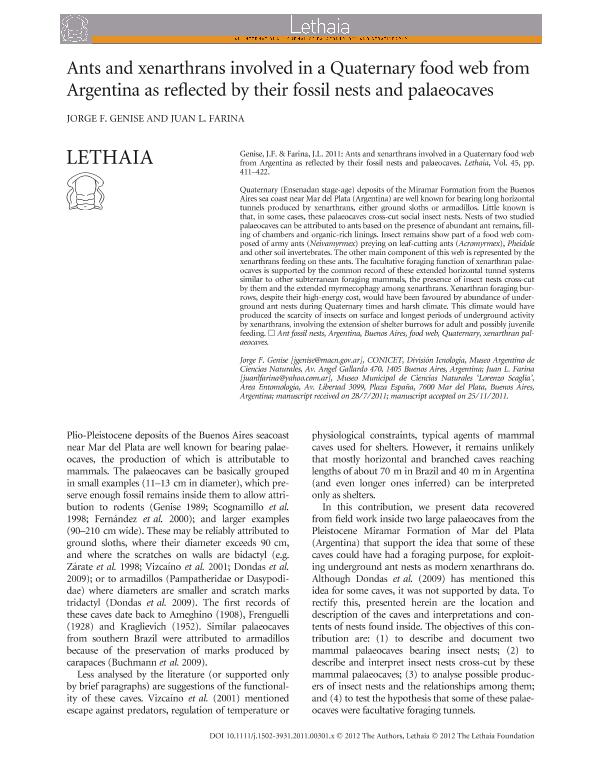Mostrar el registro sencillo del ítem
dc.contributor.author
Genise, Jorge Fernando

dc.contributor.author
Farina, Juan Luis

dc.date.available
2019-01-29T21:27:31Z
dc.date.issued
2012-07
dc.identifier.citation
Genise, Jorge Fernando; Farina, Juan Luis; Ants and xenarthrans involved in a Quaternary food web from Argentina as reflected by their fossil nests and palaeocaves; Wiley Blackwell Publishing, Inc; Lethaia; 45; 3; 7-2012; 411-422
dc.identifier.issn
0024-1164
dc.identifier.uri
http://hdl.handle.net/11336/68942
dc.description.abstract
Quaternary (Ensenadan stage-age) deposits of the Miramar Formation from the Buenos Aires sea coast near Mar del Plata (Argentina) are well known for bearing long horizontal tunnels produced by xenarthrans, either ground sloths or armadillos. Little known is that, in some cases, these palaeocaves cross-cut social insect nests. Nests of two studied palaeocaves can be attributed to ants based on the presence of abundant ant remains, filling of chambers and organic-rich linings. Insect remains show part of a food web composed of army ants (Neivamyrmex) preying on leaf-cutting ants (Acromyrmex), Pheidole and other soil invertebrates. The other main component of this web is represented by the xenarthrans feeding on these ants. The facultative foraging function of xenarthran palaeocaves is supported by the common record of these extended horizontal tunnel systems similar to other subterranean foraging mammals, the presence of insect nests cross-cut by them and the extended myrmecophagy among xenarthrans. Xenarthran foraging burrows, despite their high-energy cost, would have been favoured by abundance of underground ant nests during Quaternary times and harsh climate. This climate would have produced the scarcity of insects on surface and longest periods of underground activity by xenarthrans, involving the extension of shelter burrows for adult and possibly juvenile feeding. □Ant fossil nests, Argentina, Buenos Aires, food web, Quaternary, xenarthran palaeocaves.
dc.format
application/pdf
dc.language.iso
eng
dc.publisher
Wiley Blackwell Publishing, Inc

dc.rights
info:eu-repo/semantics/openAccess
dc.rights.uri
https://creativecommons.org/licenses/by-nc-sa/2.5/ar/
dc.subject
Paleocuevas
dc.subject
Hormigueros Fosiles
dc.subject.classification
Otras Ciencias Biológicas

dc.subject.classification
Ciencias Biológicas

dc.subject.classification
CIENCIAS NATURALES Y EXACTAS

dc.title
Ants and xenarthrans involved in a Quaternary food web from Argentina as reflected by their fossil nests and palaeocaves
dc.type
info:eu-repo/semantics/article
dc.type
info:ar-repo/semantics/artículo
dc.type
info:eu-repo/semantics/publishedVersion
dc.date.updated
2019-01-29T18:05:35Z
dc.journal.volume
45
dc.journal.number
3
dc.journal.pagination
411-422
dc.journal.pais
Reino Unido

dc.journal.ciudad
Londres
dc.description.fil
Fil: Genise, Jorge Fernando. Consejo Nacional de Investigaciones Científicas y Técnicas. Oficina de Coordinación Administrativa Parque Centenario. Museo Argentino de Ciencias Naturales “Bernardino Rivadavia”; Argentina
dc.description.fil
Fil: Farina, Juan Luis. Museo Municipal de Ciencias Naturales" Lorenzo Scaglia"; Argentina
dc.journal.title
Lethaia

dc.relation.alternativeid
info:eu-repo/semantics/altIdentifier/doi/http://dx.doi.org/10.1111/j.1502-3931.2011.00301.x
dc.relation.alternativeid
info:eu-repo/semantics/altIdentifier/url/https://onlinelibrary.wiley.com/doi/abs/10.1111/j.1502-3931.2011.00301.x
Archivos asociados
